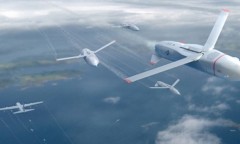By Arthur Dominic J. Villasanta , | April 04, 2017

U.S. Navy P-8A Poseidon.
The U.S. Department of Defense has awarded The Boeing Company a $2.2 billion contract to build 17 new P-8A Poseidon maritime surveillance aircraft capable of deploying the navy's new Lockheed Martin High Altitude Anti-submarine warfare Weapon Capability (HAAWC).
HAAWC is an add-on air-launched accessory (ALA) kit that transforms the navy's Mark 54 Lightweight Torpedo into a "flying bomb" with wings.
Like Us on Facebook
The P-8A is a military variant of Boeing's Next-Generation 737-800 commercial aircraft featuring advanced anti-submarine, anti-surface warfare, and intelligence, surveillance, and reconnaissance capabilities. It was designed to replace the navy's ageing fleet of Lockheed P-3 Orion anti-submarine/maritime surveillance aircraft.
The P-8A has twice the sonobuoy processing capability and can carry 30 percent more sonobuoys than any maritime patrol and reconnaissance aircraft currently flying.
It has a range of up to 7,242 kilometers without refueling, reaches speeds of up to 900 km/h. The P-8A the Raytheon Mark 54 lightweight torpedoes, mines, and depth charges, plus air-to-surface missiles on underwing hardpoints.
It will be armed with the new HAAWC, which will allow the P-8A to operate from higher altitudes during anti-submarine warfare operations. In comparison, the P-3 Orion has to descend to an altitude of around 30 meters to release its torpedoes, exposing them to anti-aircraft defenses.
HAAWC gives the Mark 54 the ability to glide through the air for long distances. It consists of a pair of folding wings; a tail unit; a GPS-guided navigation system and a parachute.
HAAWC glides downwards towards the water after launch. The ALA kit then peels off. The system deploys a parachute to slow down the Mark 54 as it plunges into the water. The torpedo activates and begins to hunt its target submarine.
The major advantage of the HAAWC is it allows the P-8 to track and kill Chinese and Russian submarines from high altitudes (over 10,000 meters, according to some sources) and for vastly longer distances.
HAAWC will be particularly effective against the new deeper diving and stealthier ballistic nuclear missile submarines operated by China and Russia.
-
Use of Coronavirus Pandemic Drones Raises Privacy Concerns: Drones Spread Fear, Local Officials Say

-
Coronavirus Hampers The Delivery Of Lockheed Martin F-35 Stealth Fighters For 2020

-
Instagram Speeds Up Plans to Add Account Memorialization Feature Due to COVID-19 Deaths

-
NASA: Perseverance Plans to Bring 'Mars Rock' to Earth in 2031

-
600 Dead And 3,000 In The Hospital as Iranians Believed Drinking High-Concentrations of Alcohol Can Cure The Coronavirus

-
600 Dead And 3,000 In The Hospital as Iranians Believed Drinking High-Concentrations of Alcohol Can Cure The Coronavirus

-
COVID-19: Doctors, Nurses Use Virtual Reality to Learn New Skills in Treating Coronavirus Patients










